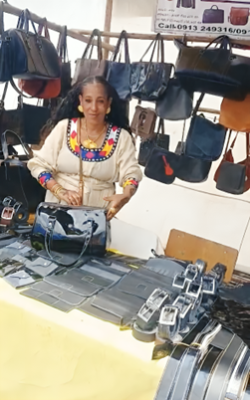The Path to Entrepreneurship
Masho’s early career began with a Diploma in Computer Science and a brief attempt at running a computer center with a 30,000 birr family loan. While that venture did not grow as planned, her entrepreneurship soon found its true calling: leather.
 During an unexpected 10-day leave to Addis Ababa, Masho assisted her brothers at a trade fair for their leather business. Inspired, she returned to Mekelle. In 2014, she established “Look Leather Products,” pouring her savings and more family loans into the business. She quickly expanded her equipment and hired six employees, working with a total capital of 1.5 million birr. She produced bags, belts, and wallets, gaining a solid customer base.
During an unexpected 10-day leave to Addis Ababa, Masho assisted her brothers at a trade fair for their leather business. Inspired, she returned to Mekelle. In 2014, she established “Look Leather Products,” pouring her savings and more family loans into the business. She quickly expanded her equipment and hired six employees, working with a total capital of 1.5 million birr. She produced bags, belts, and wallets, gaining a solid customer base.
In Ethiopia, leather is a cultural emblem, woven into the nation’s traditions and everyday life. From ceremonial items to durable goods, it reflects the country’s rich heritage and high-quality hides. Today, a growing market-led movement is supporting small-scale manufacturing, blending traditional craftsmanship with modern technology to meet local and international demands.
At the heart of this evolving industry is the story of Masho Gebremedhin, an entrepreneur from Mekelle, the capital of Tigray region. Masho’s journey is one of immense economic resilience, shaped by her commitment to rebuilding her future after unimaginable challenges.
A Spark of Hope in Crisis
The conflict in northern Ethiopia, compounded by the fallout from the COVID-19 pandemic, struck her business with devastating force. “Beyond the financial loss, the devastation on morale was incomprehensible,” she shares. Her primary supplier was heavily damaged, cutting off her leather source. After five years without work, four of her machines were broken, and sourcing spare parts became a desperate task of salvaging from what remained.
“I tried to regain my motivation by fixing machines using parts from each other,” she says. It was during these bleak times that a critical lifeline appeared.
Masho learned about the CIPE initiative through the Women Business Resource Centers (WBRCs). The WBRCs are a safe and empowering space for women entrepreneurs to learn, rebuild, and connect. The initiative, implemented in collaboration with the Alliance for Civil Society Organizations in Tigray (ACSOT) and the Tigray Women Entrepreneurs Association (TWEA), aims to grow markets by strengthening women-led businesses in post-conflict regions.
“The training program was the most brightening thing that happened to me,” Masho says.
Relaunching Through Empowerment
 Through WBRC, Masho participated in a year-long technical assistance initiative aimed at reviving conflict-affected MSMEs, enhancing business performance, creditworthiness, and, most importantly, morale.
Through WBRC, Masho participated in a year-long technical assistance initiative aimed at reviving conflict-affected MSMEs, enhancing business performance, creditworthiness, and, most importantly, morale.
“I completed one year, participating in five different training sessions, and that really transformed my perspective,” she explains. “Despite the financial challenges, the trainings were empowering and gave me a space to rebuild myself.”
The courses she attended covered a wide range of skills essential for entrepreneurship and post-conflict recovery, including women-focused business development services, financial record management, customer handling, and digital literacy. These sessions not only strengthened her practical skills but reignited her passion for free enterprise.
“I re-launched my leather-making shop thanks to the confidence and tools I gained through the training,” she says proudly.
Looking Ahead
Today, Masho earns around 30,000 birr in net monthly income, a testament to her recovery and success. She is setting her sights even higher.
“I envision having a leather factory,” she shares. Her goal is to export leather products, driving job creation and contributing to import substitution. Ultimately, she aims to support advancing reforms and the country’s broader economic recovery.
Masho Gebremedhin’s story is a profound testament to the strength of economic empowerment in rebuilding communities after crisis. Through perseverance, support, and the right opportunities, she has turned adversity into a legacy of economic resilience.
WBRCs in Ethiopia are supported by the Deutsche Gesellschaft für Internationale Zusammenarbeit (GIZ)’s PSD-E project, funded by the German Government, the European Union, and the Minister for Trade and Development Cooperation of the Netherlands.
Published Date: November 16, 2025
